How to Click a Button Using Javascript and Then Click It Again to Revert Back
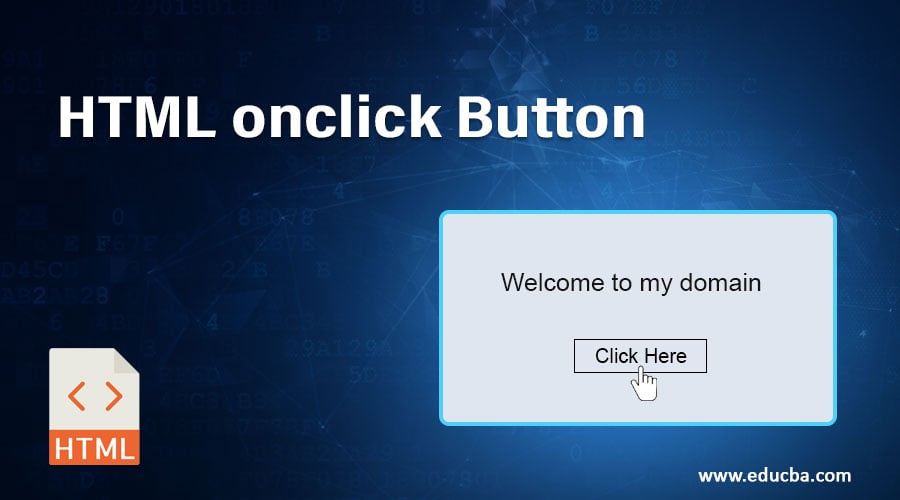
Introduction to HTML onclick Push button
In HTML, nosotros have a push for submitting the user-request data to the server(backend) to validate and navigate the web pages. Mainly, if we utilize the onclick button for event attributes and is supported by all the browsers, And then is the browser compatibility feature wherever we use this outcome function in our scripts. The upshot appears when the user clicks on the <button> tag, information technology will be used and demand to add the onclick result in the <button> element. Then the button tag runs on the script when the button is chosen or clicked by the user end. Information technology runs on the specific lines of code in the HTML object that has the onclick attribute.
Working of onclick Button
Mainly it will exist used for triggering and call the office wherever the user needs to click on the button. If the user clicks on the mouse through the <push button> chemical element in the Onclick event, it will call the functions like Javascript, etc.…The onclick effect attribute basically contains only one value for the script which works on the backend of the upshot.
Syntax:
<button name="" value="" onclick ="role()"/>
The to a higher place syntax is the basic usage of the onclick event in the html attributes. Nosotros also customized the event wherever nosotros need which is the user requirements.
Examples of HTML onclick Button
Below given are the examples of the onclick button in html:
Case #i
Code:
<html>
<trunk>
<push onclick="Office()">Click</button>
<p id="sample"></p>
<script>
function Function() {
document.getElementById("sample").innerHTML = "Welcome";
}
</script>
</torso>
</html>
Output:
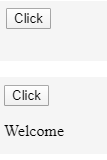
In the in a higher place case, nosotros accept created the javascript part; additionally, when the user clicks the button "click", it will display the value "Welcome" in the browser itself.
Example #ii
Code:
<html>
<body>
<p id="sample" onclick="Office()">Click</p>
<script>
function Function() {
document.getElementById("sample").innerHTML = "Welcome";
}
</script>
</body>
</html>
Output:
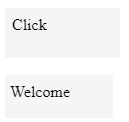
The higher up example is also the same as we discussed in the previous example 1, but hither nosotros are not using any <push> tag, instead of that we directly call the function and issue in the <p> tag(paragraph) tag. So information technology will reduce the lines of code.
Example #3
Code:
<html>
<body>
Username: <input type="text" id="user" value="sivaraman" ><br>
Countersign: <input blazon="text" id="pass"><br><br>
<push onclick="Function()">Click</button>
<script>
role Office() {
document.getElementById("pass").value = document.getElementById("user").value;
}
</script>
</torso>
</html>
Output:
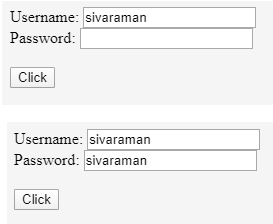
In the example above, we called the JavaScript function to copy the values from username to password later on selecting the "click" button that is automatically copied from username to countersign. It is one of the basic operations for the onclick upshot.
OnClick Effect in Various Events
- The onclick property attributes used by some other events, such as the global result handler, are too one of the effect handler mechanisms under the Event handler used to process click events in HTML Elements. Whenever the click issue is raised later on the user asking, information technology fires after the mouse down and mouse up events in some order.
- Click Event also have some triggers activeness; consider adding the same action to the "cardinal-downwards" issue is immune to utilise the aforementioned activeness past a user who does not utilise a mouse pointer or even a impact screen. Nosotros have some inbuild functions in javascript for onclick events.
- If the role receives the MouseEvent object equally its sole argument, this function will also be the outcome'due south elements to exist triggered. Only one click result handler will exist assigned for a single object at a time. If you use EventTarget.addEventListener() methods,since it's more than flexible.
For Example, if we desire to change the colors of the given values afterwards a click.
<html>
<body>
<div id="case">Click</div>
<script>
certificate.getElementById('example').onclick = function changeContent() {
document.getElementById('example').innerHTML = "Welcome to my domain";
document.getElementById('instance').mode = "Colour: light-green";
}
</script>
</torso>
</html>
Output:
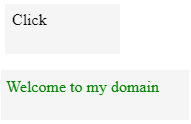
- In the example above, we just called a click result to alter the text colors on the user's screens. Like many outcome trigger functions, it may exist useful for the runtime prospectus too as user requirements.
- Onclick Event is also an attribute for the picture show objects; likewise, it contains an expression that gets evaluated when the user clicks the push or movie objects. The onclick event also does some different things depending on which part of an image is to exist clicked by the user. Generally, the handler can be set in html attributes like <event> when the user clicks using mouse cursor the code within onclick runs, html attributes names are non case sensitive, so onclick works as onClick, but usually, the attributes are used in lowercased.
- If we use the form tag to access the web pages the same thing when we press the move button, the controller can validate the user requirements in the backend logic and testify the result view. It also reloads the webpage; Sometimes the onclick outcome is not working in the javascript validations, i.e. scripts the html page wherever telephone call the functions in onclick event the user must need to be check and as well rename the function does not piece of work that time if the role onclick() is defined in the user input or like buttons it gets a higher priority than the javascript functions.
Here, a couple of suggestions that need to be helpful for using the onclick event in the html tags.
1. Practice not use the onclick="javascript:office()",but use the javascript : like prefix inside the attribute similar href hyperlink:<a href="javascript:role()">
two. We don't stop with semicolon similar onclick=" part()" and onclick=" function();" both will be work fine, merely it's not a skillful practice for using semicolon for role ends.
3. Effect attributes like onclick,onCLICK, and ONCLICK all volition be work, but in mutual exercise, nosotros write the attributes similar lowercase, fifty-fifty javascript itself case sensitive, when we write like document.getElementById().onclick=", so all must exist the lowercase.
Determination
onclick is also the event trigger in the javascript functions; it may be helpful for user validations and navigate the web pages. In jquery, also nosotros employ the onclick event human activity equally a major office of the user-defined requirements. Like, react js, athwart are some other frameworks we employ in onclick functions. It likewise supports well-nigh of the modern browsers nowadays like google chrome, Mozilla Firefox, and safari, etc. In javascript, we tin can handle non only onclick event functions, but it may also be used for some other attributes like "on select,onsubmit,ontoggle,onkeyup ", etc.. based on the user requirements, we tin use the event attributes in the html.
Recommended Manufactures
This has been a guide to HTML onclick Button. Here nosotros discuss the basic concept, working of onclick Button, examples and onclick events in various events. Yous may too have a look at the following articles to acquire more –
- Dropdown List in HTML
- HTML Color Picker
- HTML Event Attributes
- Cursor in HTML
Source: https://www.educba.com/html-onclick-button/
0 Response to "How to Click a Button Using Javascript and Then Click It Again to Revert Back"
Post a Comment